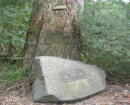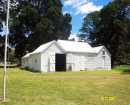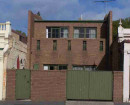STATION STREET SHOP AND DWELLING
STATION STREET CARRUM - PROPERTY NUMBER 506-507, KINGSTON CITY
-
Add to tour
You must log in to do that.
-
Share
-
Shortlist place
You must log in to do that.
- Download report
Statement of Significance
-
-
STATION STREET SHOP AND DWELLING - History
Note: References in text to Tables, Figures, Maps relate to the supporting document submitted with this site card. Land encompassing the site (506-507, Station Street Carrum) was located on the western border of the former Carrum swamp lands – within Crown Allotment (CA) 101, Parish of Lyndhurst – and is depicted in historic maps dating 1866 to 1871 as vacant land. Crown Allotment 101 (an area of ~281 acres) was first purchased in 1875 by James Nixon, a ‘tailors’ cutter’ from Melbourne (DLS 1959; SOV 1875; Figure 3). In 1881, Nixon advertised the property for sale as partially fenced land, suitable for grazing, and with a six (6) roomed weather board house and a six stall stable (The Age, 07 May 1880, p.4). The precise location of these house and stable is unknown and given the size of the property at that time it is not possible to determine if these structures were located within or in the immediate vicinity of the study area. However, the date range of the artefacts recovered from the site during CHMP testing (i.e., post-dating c.1900; see Section 5.3 ) suggests that the identified archaeological deposit is not associated with the 1881 farmhouse/stable. A later sale advertisement of 1893 describes the land as being suitable farming and subdivision into smaller farming properties (The Age, 21 Aug. 1893, p. 2). During the 1880s and 1890s, the ownership of CA 101 changed hands a number of times, and for the majority of this time period the land was owned by building societies or banks (see Table 2). The Commercial Bank of Australia foreclosed on a mortgage held on the land in 1897, and in that year the land was acquired by William Henry Breen of Cheltenham. Breen subdivided the original CA 101 and from 1899 progressively sold off allotments within the subdivision (SOV 1881, 1883a, 1883b, 1885 and 1893). Lot 37 on plan LP4108 (a land area of ~9.91 acres) encompassing the study area was purchased by Sarah Jane Rigby in 1904. By 1907, two of Sarah’s sons (Alfred James Rigby and Hugh Rigby) had purchased lots to the immediate north and east of Sarah’s allotment. Following Sarah’s death in 1907, James and Hugh inherited her land holdings, including the study area (SOV 1904; Table 2; Figure 4). In 1908, the Rigby brothers subdivided Lot 37 to create a series of smaller allotments fronting present-day Station Street, and the approximate boundaries of 506-507, Station Street, Carrum were created at this time. In 1912, the lot encompassing the study area was purchased by Walter Henry Arthur Black – a ‘Grocer’s Manager’, from Carrum (SOV 1904 and 1912; Figure 5). It is likely that the construction of the current extant shop post-dates the Rigby Brothers 1908 subdivision, and was either constructed by the Rigbys during their ownership period or by Walter Black shortly after he acquired the land in 1912. In 1914, Black advertised a two-storey shop and dwelling in Station Street, Carrum for lease – presumably the extant shop at 506-507 Station Street (Moorabbin News, Dec. 1914, p. 6). As discussed above, although the precise date that the extant shop was constructed is unknown, secondary sources suggest that the architectural style of the building dates to the ‘early twentieth’ century (Bryce Raworth P/L 2001, see Appendix A supporting document). A construction date c.1908 to 1914 – as indicated by land ownership detailed in Table 2, and discussed above – corresponds to the date suggested by the buildings architectural style. In 1922, the property was offered for sale, with a detailed description of buildings extant at that time; illustrating that the main building consisted of a residence and shop, and that an additional timber building was located in the rear yard (In order to understand the likely date and potential historic associations of the archaeological deposit identified during CHMP testing (see Section 5.0, Supporting document) a review of primary and secondary source material has been undertaken to determine the occupation and land use history of the study area (506 to 507, Station Street, Carrum). The result of this research is presented below. Land encompassing the study area was located on the western border of the former Carrum swamp lands – within Crown Allotment (CA) 101, Parish of Lyndhurst – and is depicted in historic maps dating 1866 to 1871 as vacant land. Crown Allotment 101 (an area of ~281 acres) was first purchased in 1875 by James Nixon, a ‘tailors’ cutter’ from Melbourne (DLS 1959; SOV 1875; Figure 3). In 1881, Nixon advertised the property for sale as partially fenced land, suitable for grazing, and with a six (6) roomed weather board house and a six stall stable (The Age, 07 May 1880, p.4). The precise location of these house and stable is unknown and given the size of the property at that time it is not possible to determine if these structures were located within or in the immediate vicinity of the study area. However, the date range of the artefacts recovered from the site during CHMP testing (i.e., post-dating c.1900; see Section 5.3 supporting document) suggests that the identified archaeological deposit is not associated with the 1881 farmhouse/stable. A later sale advertisement of 1893 describes the land as being suitable farming and subdivision into smaller farming properties (The Age, 21 Aug. 1893, p. 2). During the 1880s and 1890s, the ownership of CA 101 changed hands a number of times, and for the majority of this time period the land was owned by building societies or banks (see Table 2). The Commercial Bank of Australia foreclosed on a mortgage held on the land in 1897, and in that year the land was acquired by William Henry Breen of Cheltenham. Breen subdivided the original CA 101 and from 1899 progressively sold off allotments within the subdivision (SOV 1881, 1883a, 1883b, 1885 and 1893). Lot 37 on plan LP4108 (a land area of ~9.91 acres) encompassing the study area was purchased by Sarah Jane Rigby in 1904. By 1907, two of Sarah’s sons (Alfred James Rigby and Hugh Rigby) had purchased lots to the immediate north and east of Sarah’s allotment. Following Sarah’s death in 1907, James and Hugh inherited her land holdings, including the study area (SOV 1904; Table 2; Figure 4). In 1908, the Rigby brothers subdivided Lot 37 to create a series of smaller allotments fronting present-day Station Street, and the approximate boundaries of 506-507, Station Street, Carrum were created at this time. In 1912, the lot encompassing the study area was purchased by Walter Henry Arthur Black – a ‘Grocer’s Manager’, from Carrum (SOV 1904 and 1912; Figure 5). It is likely that the construction of the current extant shop post-dates the Rigby Brothers 1908 subdivision, and was either constructed by the Rigbys during their ownership period or by Walter Black shortly after he acquired the land in 1912. In 1914, Black advertised a two-storey shop and dwelling in Station Street, Carrum for lease – presumably the extant shop at 506-507 Station Street (Moorabbin News, Dec. 1914, p. 6). As discussed above, although the precise date that the extant shop was constructed is unknown, secondary sources suggest that the architectural style of the building dates to the ‘early twentieth’ century (Bryce Raworth P/L 2001, see Appendix A of supporting document). A construction date c.1908 to 1914 – as indicated by land ownership detailed in Table 2, and discussed above – corresponds to the date suggested by the buildings architectural style. In 1922, the property was offered for sale, with a detailed description of buildings extant at that time; illustrating that the main building consisted of a residence and shop, and that an additional timber building was located in the rear yard (Frankston and Somerville Standard, 03 February, 1922, p. 2). Between 1922 and 1950, the land was purchased by a number of individuals who operated a variety of commercial business from the extant shop including: Victor Mossentor - Storekeeper (1929-1933); Burt Reynolds – butcher (1944-1946); Peter Wade – greengrocer (1946-1947); and Arthur Reuben – butcher (1947-1949). Ownership of the property reverted to members of the Rigby family (Hugh and Ruth Rigby) several times during this period, from 1922 to 1929 and from 1933 to 1944 (see Table 2; Map 3). The Rigsbys owned a number of properties at Carrum during this period, and although they may have occupied the store during their ownership period, it is also possible that they leased it out as a commercial property during their ownership period. It is likely that the buildings within the property boundaries continued to function both as a residential and a commercial premises during this period. A review of aerial imagery dating 1939 (Map 3) illustrates the location of structures/features extant at that time: • The main building (shop/residence; Structure A) fronting Station Street (west); • A square building in the rear yard (Structure B) – presumably the timber buildings described in the 1922 sale advertisement (central); • A likely detached building immediately southeast of the main shop/residence (Structure C) • Trees/garden area and possible fencing in the year yard (central) • Trees and grassed land (east) A review of aerial imagery dating 1944 to present (Map 4 to Map 9) indicates that: • By 1956, the timber building in rear yard area (Structure B) had been demolished/removed and land to the rear of the extant buildings and several mature trees in the remainder of the property appears as grassed land. • The detached building (Structure C) southeast of the shop/residence appears to have been removed between 1956 and 1979. • Between 1979 and 1984, no significant landform modifications are evidenced in aerial imagery reviewed during this assessment. • A number of modifications to the rear yard area of the property are evidence in areal imagery dating 1984 to 2022 – including: Construction and subsequent removal of internal property fencing; Construction of a paved area/concrete slab to the rear of the shop/residence; Gravel surfacing of the rear yard area. Between 1922 and 1950, the land was purchased by a number of individuals who operated a variety of commercial business from the extant shop including: Victor Mossentor - Storekeeper (1929-1933); Burt Reynolds – butcher (1944-1946); Peter Wade – greengrocer (1946-1947); and Arthur Reuben – butcher (1947-1949). Ownership of the property reverted to members of the Rigby family (Hugh and Ruth Rigby) several times during this period, from 1922 to 1929 and from 1933 to 1944 (see Table 2; Map 3). The Rigsbys owned a number of properties at Carrum during this period, and although they may have occupied the store during their ownership period, it is also possible that they leased it out as a commercial property during their ownership period. It is likely that the buildings within the property boundaries continued to function both as a residential and a commercial premises during this period. A review of aerial imagery dating 1939 (Map 3) illustrates the location of structures/features extant at that time: • The main building (shop/residence; Structure A) fronting Station Street (west); • A square building in the rear yard (Structure B) – presumably the timber buildings described in the 1922 sale advertisement (central); • A likely detached building immediately southeast of the main shop/residence (Structure C) • Trees/garden area and possible fencing in the year yard (central) • Trees and grassed land (east) A review of aerial imagery dating 1944 to present (Map 4 to Map 9) indicates that: • By 1956, the timber building in rear yard area (Structure B) had been demolished/removed and land to the rear of the extant buildings and several mature trees in the remainder of the property appears as grassed land. • The detached building (Structure C) southeast of the shop/residence appears to have been removed between 1956 and 1979. • Between 1979 and 1984, no significant landform modifications are evidenced in aerial imagery reviewed during this assessment. • A number of modifications to the rear yard area of the property are evidence in areal imagery dating 1984 to 2022 – including: Construction and subsequent removal of internal property fencing; Construction of a paved area/concrete slab to the rear of the shop/residence; Gravel surfacing of the rear yard area.STATION STREET SHOP AND DWELLING - Interpretation of Site
(See Supporting documentation for additional details) With consideration given to the established land use history (Section 4.0); and the interpretation of the historic archaeological deposit identified during CHMP testing (Section 5.0) it is evident that the potential for significant historic archaeological features and/or deposits to be preserved within the study area varies, in summary: • It is likely that any significant archaeological deposits and/or features located at the site will be preserved beneath non-significant (post c.1950) deposits, likely at a depth =0.4m below the current surface level. • There is negligible to low potential for previously unidentified archaeological structures of high archaeological significance to be preserved within the western portion of the study area (i.e., within the footprint of the extant shop/dwelling and concrete slab in the northwest of the yard area). • There is a moderate potential for archaeological structures/of low to moderate significance to be preserved within the rear yard area (central and southwest); including, timber footings associated with pre-1914 and pre-1956 buildings identified from historic research as having been located in the rear yard of the property. • There is high potential for additional artefact-bearing deposits of moderate significance to be located in the immediate vicinity of TP1.
Heritage Inventory Description
STATION STREET SHOP AND DWELLING - Heritage Inventory Description
Recent aerial imagery, and the results of the site survey undertaken for a CHMP (no.19305; 08 March 2023) indicates that an historic shop/dwelling remains is extant in the western portion of the site and that the remainder of the site currently consist of a graveled yard area, as summarized below and illustrated in Map 2 and Plate 1 to Plate 3 in the provided supporting documentation. Currently within the study area, these landscape elements and structures are evident: Two storey and one storey building/s (historically significant shop/dwelling) – fronting Station Street (west); Concrete paved area to the rear of the above buildings (northwest); Lightweight and/or temporary structures (southwest and northeast); and Gravel yard area (central and east). During the complex assessment for a CHMP a 1.0m x 1.0m test trench (TP1) was manually excavated in the rear yard of the property (see Map 10, supporting document for location), during the excavation of this test trench a stratified deposit of historic artefacts was encountered – details of the excavation findings are provided in Section 5.0 of the reporting document.
-
-
-
-
-
RULES OF THE MELBOURNE FOOTBALL CLUB
 Victorian Heritage Register H2428
Victorian Heritage Register H2428 -
MOUNT LITTLE DICK FIRE TOWER
 Victorian Heritage Register H2461
Victorian Heritage Register H2461 -
NORTH MELBOURNE POTTERY
 Victorian Heritage Inventory
Victorian Heritage Inventory
-
-








